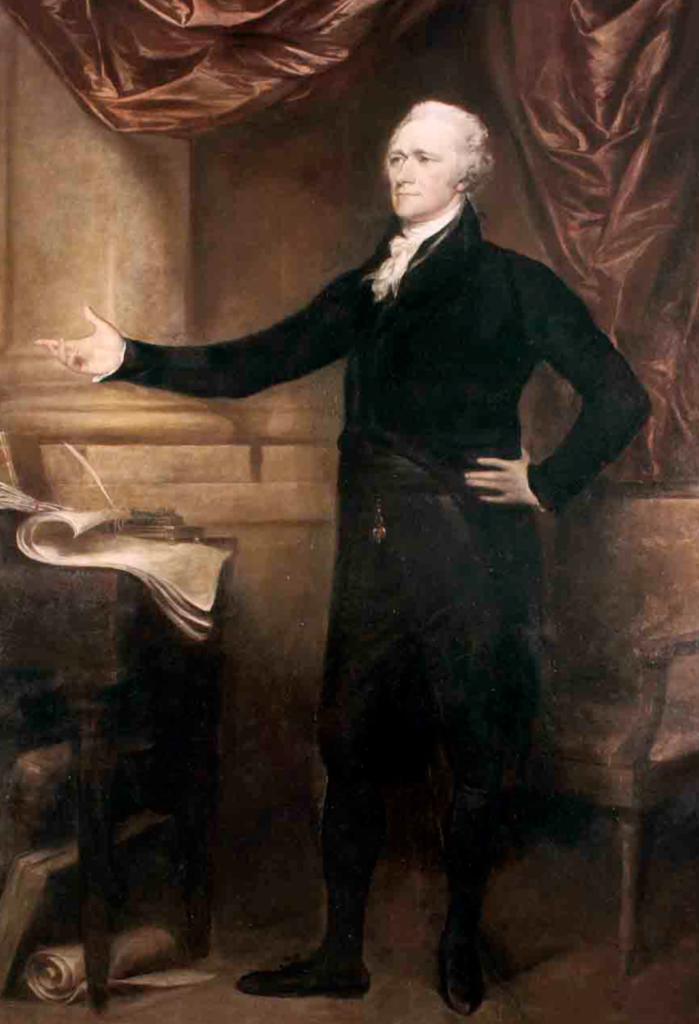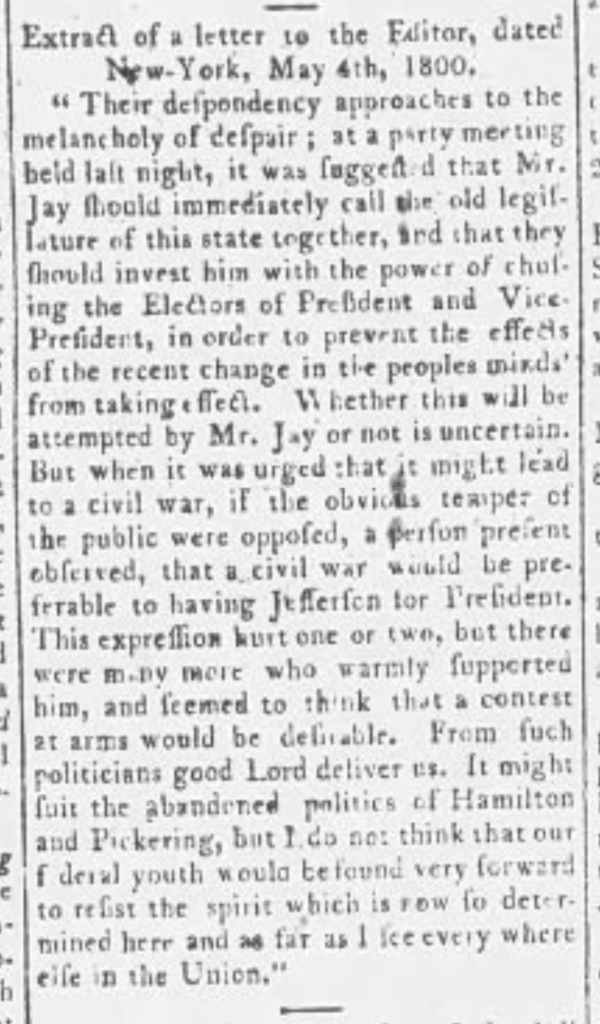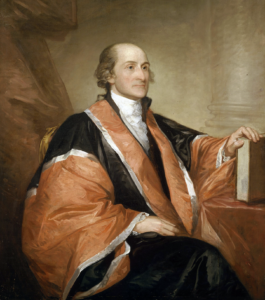Hamilton’s most undemocratic moment ?
And its inapplicability as a precedent for 2020
Many seeking to understand the election of 2020 attempt to draw comparisons to the elections of 1800, 1824 and 1876. In particular, some have suggested that Hamilton’s proposal in May of 1800 to change the method of selecting presidential electors in New York is a possible precedent for overturning the popular vote in several pivotal swing states 2020. This blog post argues that extraordinary efforts to throw the 2020 election into a contingent election in the House of Representatives is not supported by Hamilton’s controversial May 7, 1800 proposal to John Jay discussed below.
Historians have roundly criticized the timing of Hamilton’s May 7, 1800 proposal to Governor Jay. As acknowledged by Hamilton, he was admittedly motivated by blatantly partisan motives when recommending that the New York presidential election be made more democratic. He also knew that it would be difficult to defend against charges of hypocrisy. Nevertheless, while Hamilton was suggesting that New York change the election process in the year of a presidential election, it is important to understand that he was recommending that the New York popular vote be used (not ignored) in what was likely to be a close national election.
Before assigning Hamilton’s imprimatur to efforts to defeat the popular vote in the 2020 election, it is important to recognize key distinctions, along with the full context of Hamilton’s reasoning two hundred and twenty years ago.

Hamilton’s controversial letter to Jay
In a letter dated May 7, 1800 to New York Governor John Jay, Alexander Hamilton proposed that the lame duck New York Legislature should be called into special session to change the method of selecting presidential electors for the upcoming presidential election of 1800. The Federalists had just suffered heavy electoral losses in New York City. Hamilton correctly feared that the recent loss of legislative seats in the New York Assembly, which was scheduled to convene in July of 1800, would be translated into electoral votes for Thomas Jefferson when the electoral college votes were counted in February of 1801.
By way of background, in the year 1800 only five states selected the president based on popular vote. In ten states the state legislature appointed presidential electors legislatively. In other words, in New York and nine other states, presidential electors where determined by legislative appointment. In the one remaining state a mixed process was used. By the year 1832, almost all states moved to the current system of electing presidents by popular vote funneled through the electoral college.
After heavily campaigning in New York City, Hamilton’s Federalists were defeated in the hard fought New York Assembly election that was held from April 29 to May 1, 1800. As described by Ron Chernow, Hamilton and the New York Federalists understood that this election “portended a fundamental realignment in American politics.” In no small part, the Democratic-Republican victory was due to a highly effective political machine overseen by Aaron Burr.
Upon learning of their election losses, the New York Federalists attended a party caucus on May 4. Reeling from their defeat, the Federalists knew that the newly constituted New York Assembly (to be controlled by 85 Democratic-Republicans and only 65 Federalists) could deliver all twelve of New York’s electoral delegates to Jefferson. During the party meeting, it was proposed that a new law be promptly adopted assigning the power to appoint presidential electors to Federalist Governor John Jay.
As described in a hostile newspaper, the Aurora (pictured below):
Their [the Federalists’] despondency approaches to the melancholy of despair; at a party meeting held last night, it was suggested that Mr. Jay should immediately call the old legislature of this state together, and that they should invest him with the power of choosing the Electors of President and Vice-President, in order to prevent the effects of the recent change in the peoples minds’ from taking effect….


While the accuracy of the Aurora‘s reporting is unclear, Hamilton biographer Richard Brookhiser agrees that the New York Assembly election was the “first bellwether” of the presidential election of 1800 and a “crucial test.” Under these circumstances, the despondency of the New York Federalists, who had been beaten in their home territory, was certainly understandable.
Three days later, Hamilton wrote his controversial letter to Governor Jay. Hamilton did not propose, as seemingly suggested by the Aurora report, that Jay be given the authority to appoint presidential electors. Rather, Hamilton’s May 7 letter proposed that a special session of the New York Assembly be called to change the law to replace legislative appointment of electors with appointment of electors by popular vote. This not too subtle change in procedures would salvage presidential electors for the Federalist candidates (John Adams and Charles Pinckney) in the districts controlled by Federalists.
In his May 7 letter to Jay, Hamilton acknowledged the near certainty that there would be an anti-Federalist majority in the next session of the New York Assembly. Hamilton also anticipated the “very high probability” that this will bring Jefferson into the Chief Magistracy”:
unless it be prevented by the measure which I shall now submit to your consideration, namely the immediate calling together of the existing Legislature.
Hamilton conceded that his proposal was subject to “weighty objections”, but he argued that the recommendation was both “legal and constitutional”:
I am aware that there are weighty objections to the measure; but the reasons for it appear to me to outweigh the objections. And in times like these in which we live, it will not do to be overscrupulous. It is easy to sacrifice the substantial interests of society by a strict adherence to ordinary rules.
In observing this, I shall not be supposed to mean that any thing ought to be done which integrity will forbid—but merely that the scruples of delicacy and propriety, as relative to a common course of things, ought to yield to the extraordinary nature of the crisis. They ought not to hinder the taking of a legal and constitutional step, to prevent an Atheist in Religion and a Fanatic in politics from getting possession of the helm of the State.
Jay’s Wisdom
To Jay’s credit, the prudent Governor (and close ally of Hamilton) ignored Hamilton’s request. As described by historian Richard Leffler, “[t]rue to his character, Jay did not deign to answer Hamilton’s letter.” Jay merely noted on the back of Hamilton’s letter that it was “proposing a measure for party purposes which I think it would not become me to adopt.” Click here for a link to Leffler’s blog post on the website of the Center for the Study of the American Constitution.
Leffler praises Jay by quoting John Adams, “who did not throw around compliments”. For Adams, Jay was “an honest Man . . . a Man of Honor, a Man of principle, a Man of Religion.”
The Center for the Study of the American Constitution opines that in the year 2020 people of good will would agree that giving the legislature the power to decide how to cast electoral votes after the people have spoken in an election “would not become us…” Statutesandstories.com agrees with John Jay, John Kaminski, Richard Leffler and the Center for the Study of the American Constitution.
It is also worth noting that Hamilton was not the only Federalist reaching out to Jay to take drastic steps. For example, Hamilton’s father-in-law and former New York Senator, Philip Schuyler, wrote his own letter dated May 7 to Jay indicating that Hamilton’s proposal had the backing of “our Federal friends in Congress” who had entrusted Schuyler to write to Jay.
Schuyler agreed that the proposed strategy might involve “embarrassment” and that the “enemies of order and good government” would be “loud in their censures of the measure.” Nevertheless, Schuyler argued that it was “the only way to save [the] nation from more disasters” that would befall the country if it came under the “mis-rule” of Jefferson, who was “pervaded with the mad French philosophy.” According to Schuyler’s hyperbole, it was “impossible to appreciate all the painful results which may ensue from Mr. Jefferson’s conduct, should he be president,” including the risk of war with Britain. “It seems to me,” Schuyler wrote, that “these considerations will justify the Measure of calling the Legislature.” For emphasis, Schuyler added a post-script to the bottom of his letter indicating that, “Mr. Marshall is one of those who has recommended the measure above mentioned.”
Historians have understandably admired Jay’s “integrity” and “rectitude” and his refusal “to manipulate established procedures for the sake of party politics.” As described by Gary Stein in a blog for the Center for Ethics and the Rule of Law, “[n]o governor or state legislature in the 220 years since has defied the precedent Jay set.”
In defense of Hamilton: critical distinctions in 2020
As set forth below, in this blog post Statutesandstories.com argues that it is important to fully place Hamilton’s May 7 letter in its proper context before attempting to extrapolate from Hamilton’s proposal.
Historian Stephen F. Knott offers perhaps the strongest defense of Hamilton’s May 7 letter. For Knott, changing the selection process for presidential electors was “the norm at this time”:
It is important to note that the alteration of the selection process for presidential electors for partisan reasons was the norm at this time. Five states changed their election laws in 1800 to make them less democratic, including Virginia. Jefferson and his lieutenants opted for a statewide system that ensured that no electors were selected from a Federalist district in Virginia, even though Jefferson once argued that “the minority is entirely unrepresented” in such a system….
Citing historian Forrest McDonald, Knott concedes that Hamilton had been “universally condemned” for his proposal, “despite the fact that the process he sought to overturn did not directly represent the will of the people.” Moreover, Hamilton’s May 1800 strategy “was consistent with his lifelong support for the direct election of electors by district.” In fact, less than two years later, on January 29, 1802. Hamilton recommended the adoption of a constitutional amendment to permit this procedure. Hamilton’s resolution declared that direct election of electors was “a necessary safeguard in the choice of a President and Vice President against pernicious dissension” and the most effective means of “obtaining a full and fair expression of the public will…” By contrast, in 2020 it cannot be said that setting aside millions of votes is in keeping with America’s longstanding tradition of respecting the popular vote.
Historian Joanne Freeman similarly describes Hamilton’s “ploy” as part of the existing “constitutional tradition” intended to preserve “constitutional order”:
Rather than an anomalous moment of corruption, Hamilton’s ploy was in the constitutional tradition; indeed, it was an attempt to maintain constitutional order in the face of a looming Republican threat. And, though Hamilton alone usually shoulders the blame for electoral sinning, in truth, many others resorted to the same logic, manipulating the rules of the game at the last minute to ensure the public safety and the general good. Given the lessons of the presidential election of 1796-the first without George Washington, and thus the first true presidential contest-such attempts seemed logical. The 1796 electors had proven entirely unpredictable, their loyalties ever-shifting, dissolving the national election into a cluster of local debates and controversies.
Indeed, Burr himself had earlier proposed replacing legislative appointment of electors in New York with popular election by district.
For biographer Richard Brookhiser, Hamilton’s proposal “was a consistent position of Hamilton’s from his speech at the Constitutional Convention onward.” Indeed, the “Hamilton plan” set forth in Hamilton’s June 18, 1787 Convention speech called for the president to be “chosen by electors chosen by the people in the election districts aforesaid.” Yet, Brookhiser suggests that the arguments in Hamilton’s May 7 letter made it the “worst he ever wrote.” Brookhiser explains Hamilton’s thinking as “an anomaly borne of shock and despair.”
Ron Chernow labels Hamilton’s letter “the most high handed and undemocratic of his career.” Broadus Mitchell, another Hamilton biographer, described Hamilton’s proposal as “desperate and degrading,” despite Hamilton’s claim that the action was “legal and constitutional.” An avowed admirer of Hamilton, Senator Henry Cabot Lodge deemed the proposal “the one dark blot upon the public career of Hamilton.” For Lodge, the error could not be palliated by the fact that Federalists in Congress urged Hamilton to advance the proposal. For Jefferson biographer John Meacham, Hamilton’s May 7 letter was merely “a classic Hamilton maneuver.”
Inapplicability to 2020
With regard to the election of 2020, Statutesandstories.com argues that Hamilton’s letter of May 7 does not provide any meaningful precedent for overriding the popular vote in 2020. In fact, for the reasons set forth below, Hamilton’s arguments (and their rejection by Jay) provide no legal justification for any state legislature or governor – in a swing state or otherwise – to intervene in the election of 2020.
While Hamilton’s suggestion to Jay was admittedly Machiavellian, it is useful to place it into its broader context. In other words, Hamilton’s rejected proposal is readily distinguishable from the extra-constitutional actions being suggested to reverse the popular vote in 2020:
1) Vindication of the popular vote: At the end of the day, Hamilton’s proposal was fundamentally an effort to make the election of 1800 more democratic and representative of the popular will, not less democratic. If it had been acted on by Governor Jay, New York’s electoral delegates would more accurately capture the popular vote and public opinion in New York. By contrast, the pressure being applied by President Trump in 2020 would accomplish the exact opposite, anti-democratic result, which would be contrary to the two-hundred and twenty year arc of American history.
2) Voting timeline: The election schedule in 1800 was very different than today. During the election of 1800, the Joint Session of Congress to count the electoral college vote was not scheduled until February of 1801 (10 months after the New York legislative elections lost by the Federalists). Unlike today, the lame duck Federalist House of Representatives was charged with counting electoral votes for the election of 1800. This would be revised by the 20th Amendment.
Moreover, the Electoral Count Act of 1887 subsequently put in place voting procedures that were simply not imaginable in 1800, prior to the adoption of the Twelfth Amendment. By contrast, President Trump is seeking intervention by swing state legislatures/governors after presidential elections have taken place in all 50 states.
3) Evolving v. long settled electoral landscape: In the year 1800, six states revised their election procedures (not least of which was Virginia, the largest state at the time). In other words, Hamilton was in part responding to the changed electoral landscape, which was continuing to evolve at the time. Professors Freeman and Knott make this point that changing rules were standard practice in 1800. Indeed, Burr himself had proposed replacing legislative selection of electors with popular election by district when it served Burr’s political interests.
As recently recognized by the Supreme Court, by 1832 all states but one had settled upon the use of popular elections rather than legislative appointment of electors. See Chiafalo v. Washington (unanimously holding that “faithless electors” can be required to comply with their presidential voting obligations). By comparison, President Trump cannot legitimately object to bi-partisan mail-in-balloting laws adopted by Republican legislatures, many of which have been in effect for years preceding the 2020 election.
4) Genuine fears for the Union: Hamilton and other New York Federalists genuinely feared for the survival of the Constitution under Jefferson. By way of example, the memory of the Virginia and Kentucky Resolutions was still fresh, having been approved in late 1798. According to historian Gordon Wood, Federalists believed that Jefferson wanted to take the country back to something resembling the Articles of Confederation. As indicated in Philip Schuyler’s letter to Jay, Federalists in Congress also feared that a victory by Jefferson would likely result in war with Britain.
5) Lack of formal votes for president in May of 1800: While Burr, Jefferson and the New York Democratic-Republicans could have been expect to vigorously oppose Hamilton’s proposal, no formal voting for President had yet occurred in New York in May of 1800. The New York Presidential vote in 1800 would be subsequently determined by the New York Assembly, which had not yet taken any action to select a president (and wasn’t even in session). By contrast, President Trump is unashamedly seeking to set aside millions of votes cast during an actual presidential election.
Click here for a discussion of the Election of 1800 and its outcome. Click here for a discussion of the Election of 1876 and the Electoral Count Act of 1887. Click here for a discussion of Why 2020 is not 1800, 1824, or 1876.
Additional reading:
Stephen F. Knott, Alexander Hamilton and the Persistence of Myth (2002)
Broadus Mitchell, Alexander Hamilton: The National Adventure 1788-1804 (1962)
Henry Cabot Lodge, Alexander Hamilton (1882)
The Election of 1800-1801, The Lehrman Institute
When Alexander Hamilton Tried to Steal the Election of 1800, Clay Jenkinson (11/20/2020)
